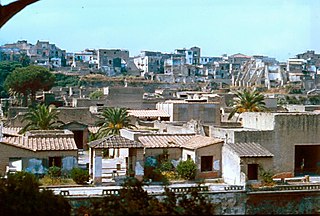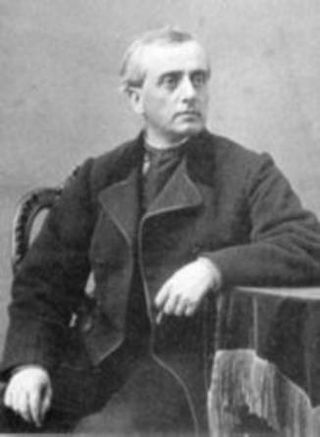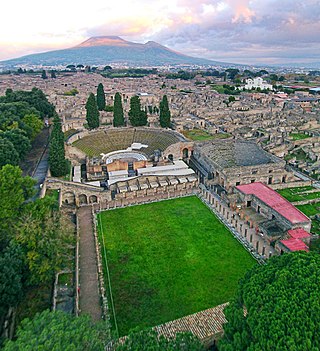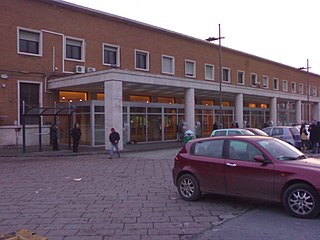
Pompei or Pompeii is a city and commune in the Metropolitan City of Naples, Italy, home of the ancient Roman ruins of Pompeii that are part of the UNESCO World Heritage Sites.

Sorrento is a town overlooking the Bay of Naples in Southern Italy. A popular tourist destination, Sorrento is located on the Sorrentine Peninsula at the south-eastern terminus of the Circumvesuviana rail line, within easy access from Naples and Pompei. The town is widely known for its small ceramics, lacework and marquetry (woodwork) shops.

Circumvesuviana is a railway network in the east of the Naples metropolitan area, previously run by a company of the same name, now operated by Ente Autonomo Volturno. Electrically powered throughout, the system uses the narrow gauge of 950 mm and operates 142 km (88 mi) of route on six lines. It is entirely separate from other national and regional railway lines. It has 96 stations with an average interstation distance of 1.5 km (0.9 mi).

Ercolano is a town and comune in the Metropolitan City of Naples, Campania of Southern Italy. It lies at the western foot of Mount Vesuvius, on the Bay of Naples, just southeast of the city of Naples. The medieval town of Resina was built on the volcanic material left by the eruption of Vesuvius that destroyed the ancient city of Herculaneum, from which the present name is derived. Ercolano is a resort and the starting point for excursions to the excavations of Herculaneum and for the ascent of Vesuvius by bus. The town also manufactures leather goods, buttons, glass, and the wine known as Lacryma Christi.

The Naples Metro is the rapid transit system serving the city of Naples, Italy. The system comprises three underground rapid transit lines.

The Villa of the Mysteries is a well-preserved suburban ancient Roman villa on the outskirts of Pompeii, southern Italy. It is famous for the series of exquisite frescos in Room 5, which are usually interpreted as showing the initiation of a bride into a Greco-Roman mystery cult. These are now among the best known of the relatively rare survivals of Ancient Roman painting from the 1st century BC.

Venezia Santa Lucia is the central station of Venice in the north-east of Italy. It is a terminus and located at the northern edge of Venice's historic city . The station is one of Venice's two most important railway stations; the other one is Venezia Mestre, a mainline junction station on Venice's mainland district of Mestre. Both Santa-Lucia and Mestre stations are managed by Grandi Stazioni and they are connected to each other by Ponte della Libertà.

Giuseppe Fiorelli was an Italian archaeologist. His excavations at Pompeii helped preserve the city.

Pompeii was an ancient city located in what is now the comune of Pompei near Naples in the Campania region of Italy. Pompeii, along with Herculaneum and many villas in the surrounding area, was buried under 4 to 6 m of volcanic ash and pumice in the Eruption of Mount Vesuvius in 79 AD.

Stabiae was an ancient city situated near the modern town of Castellammare di Stabia and approximately 4.5 km southwest of Pompeii. Like Pompeii, and being only 16 km (9.9 mi) from Mount Vesuvius, this seaside resort was largely buried by tephra ash in 79 AD eruption of Mount Vesuvius, in this case at a smaller depth of up to five metres.

Napoli Centrale is the main railway station in the city of Naples and in southern Italy and the sixth largest station in Italy in terms of passenger flow with an annual ridership of 50 million. It is located next to Piazza Garibaldi to the east of the old city. It is the primary rail terminus and station for Naples, and serves Trenitalia national railways and EAV. This one has an underground section known as Stazione di Napoli Piazza Garibaldi, which is served by the metropolitan trains of the line 2, line 1 (Garibaldi), and 3, 12, 14, and 15 EAV Circumvesuviana lines which is accessible from 2 entrances inside the Centrale station, 1 outside in glass, and from the new Garibaldi Square.

The Royal Palace of Portici is a former royal palace in Portici, Southeast of Naples along the coast, in the region of Campania, Italy. Today it is the home of the Orto Botanico di Portici, a botanical garden operated by the University of Naples Federico II. These gardens were once part of the large royal estate that included an English garden, a zoo and formal parterres.

Napoli Mergellina railway station serves the city and comune of Naples, in the region of Campania, Southern Italy. Opened in 1925, it is the third most important railway station in Naples, after Napoli Centrale and Napoli Campi Flegrei. It also forms part of the Villa Literno–Napoli Gianturco railway.

Caserta railway station serves the city and comune of Caserta, in the region of Campania, southern Italy. Opened in 1843, it forms the junction between the Rome–Cassino–Naples railway and the Naples–Foggia railway.
Santa Maria del Soccorso is a church located within the archaeological site of Villa Jovis, on the island of Capri, Italy. It is situated on the summit of the Lo Capo hill at the eastern extremity of the island. The chapel-like church, was constructed ca. 1610. Its fittings include a bronze statue of the Madonna, a 1979 gift of the Caprese painter Guido Odierna (1913-1991). In the late 19th century, hermit lived at the church, keeping a visitor's book and selling wine.

Mastroberardino is an Italian winery located in Atripalda, in Provincia di Avellino, in the Campania region. Founded in 1878, the winery is known for its production of Taurasi DOCG as well as its ampelography work in identifying and preserving ancient grape varieties like Greco and Fiano. The work of the Mastroberardino family, particularly Antonio Mastroberardino, in this field is widely respected and Antonio is often called "The Grape Archaeologist".

Naples Metropolitan Railway service are two independent companies that operate a commuter rail system in Naples. The first one, Trenitalia, operates line 2 from Pozzuoli Solfatara to Gianturco station in East of Naples. The other one, EAV, operates the Circumvesuviana, Cumana, Circumflegrea and MetroCampania NordEst. In Italy, Naples is the only city possessing two independent metropolitan railway service companies.

Napoli Porta Nolana station is the main and terminal station of the Circumvesuviana railways, today managed by the Ente Autonomo Volturno (EAV).
Gaetano d'Ancora was an Italian classical scholar and archeologist, active near Naples.
The Ente Autonomo Volturno S.r.l., also known by the acronym EAV, is a company that operates in the sector of public transport by road, rail and cableway, in the Campania Region.

















